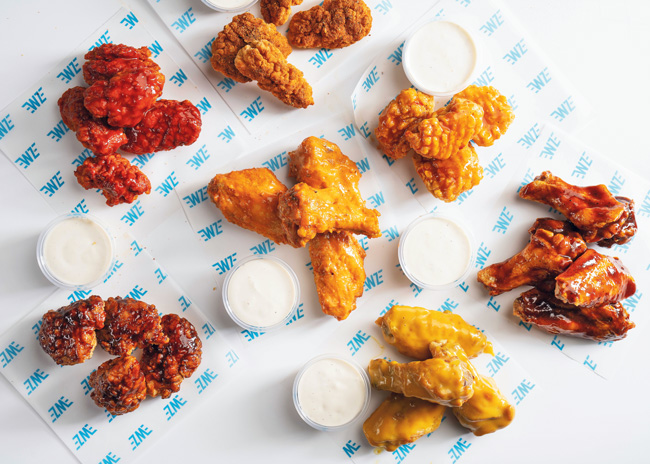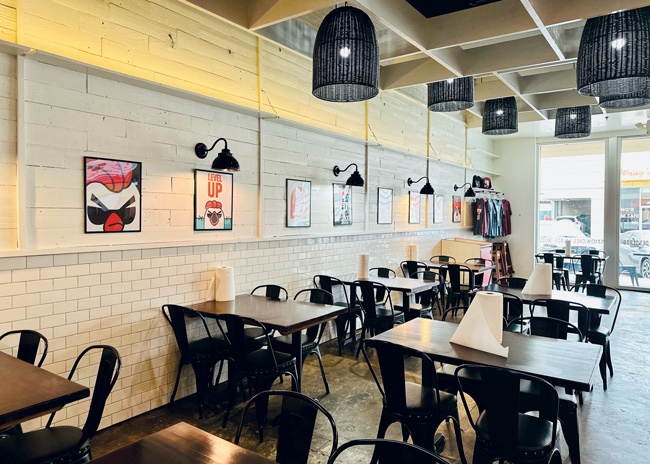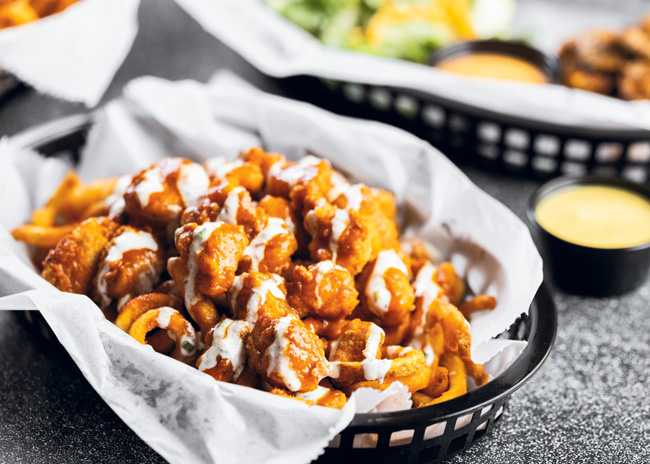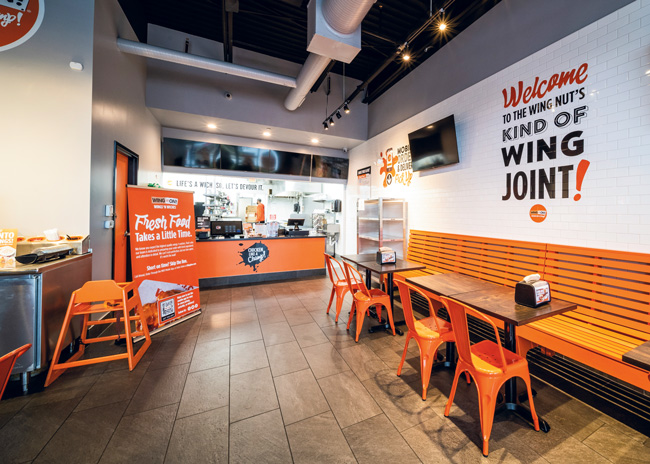Innovation and differentiation help chains hold their place in the pecking order.
 Photo courtesy of Wing ZoneWing concepts are seemingly everywhere, and the word in the chicken coop is they’re not going away. While a number of brands dominate the market — Wingstop, Wing Zone, Buffalo Wild Wings — smaller brands continue to launch and take flight.
Photo courtesy of Wing ZoneWing concepts are seemingly everywhere, and the word in the chicken coop is they’re not going away. While a number of brands dominate the market — Wingstop, Wing Zone, Buffalo Wild Wings — smaller brands continue to launch and take flight.
“We are seeing increases in wing-centric locations that are either fast casual or QSR,” says Claire Conaghan, associate director, publications at market research firm Datassential, Chicago. “[It’s] likely a reaction to the success of wing-focused ghost restaurants during the pandemic.”
What’s helping drive the ubiquity of chicken wings is that they’ve become accepted as a meal in their own right, says David Bloom, chief development and growth officer, Wing Zone, Las Vegas. “It used to be you only had chicken wings when watching football, but now it’s accepted as an entree.”
Matt Ensero, brand president, Wing It On! agrees. “They used to be more of a niche product. In the last 20 years they’ve evolved to become a more center-of-the-plate product,” he says.
Some operators see chicken wings as more of a dinner and late-night business, but others see opportunity to increase wing sales during the lunch daypart. “You have to be very careful you don’t dilute yourself — if you try to become everything to everyone, you become nothing to anyone,” adds Danny Bendas, managing partner, Synergy Restaurant Consultants, Costa Mesa, Calif. For operators looking to grow their business, especially at lunch, he suggests they consider other items as a line extension. “You want a natural extension like boneless and grilled for that healthier halo,” he explains.
Winging the Market
Not only do new chicken wing concepts open frequently, but restaurants of every stripe continue to add wings to their menus, which “dilutes the market for wing-centric brands,” says Arlene Spiegel, a restaurant consultant in New York City. “Wings are also sold at retail supermarkets and gourmet stores, allowing people to heat and serve at home. All of these options impact sales.”
Capriotti’s acquired Wing Zone three years ago. “The brand had already been around for more than 25 years, and they were early pioneers in the wing space in terms of having a variety of sauces, so we acquired a company with a reputation for being innovative,” says Bloom. “But we felt they weren’t growing at the pace we thought they could grow.”
Since then, Wing Zone has grown its number of units to 85 from 61 at the time of the acquisition, about half of them international locations, with another 150 stores in development. Most stores are franchised, but there are two corporate stores, with more to come. “We’ll continue to open more corporate stores in Vegas,” says Bloom, “because when you open in Vegas, it gets a lot of exposure.”
By the end of this year, Wing It On! will have 15 stores — three corporate locations and 12 franchised stores. The concept, which is part of South Elgin, Ill.-based Craveworthy Brands, will continue to grow with at least 10% of store count being corporate locations, says Ensero. The goal is to have 100 units signed and in development by the end of 2024 and another 200 in 2025.
New concepts continue to emerge as entrepreneurs step into the wing segment.
Bobby Shuey is the founder of Bad Chicken, which has one location in Dallas, and he’ll soon be moving that location to a new spot with a drive-thru. He plans to first expand this concept in the Dallas-Fort Worth area, via franchising.
While restaurants with wings on the menu may appeal to wing lovers, restaurants serving just wings, says Spiegel, “are engaging adventurous eaters seeking authentic flavors and preparations beyond the typical Buffalo hot sauce offerings.”
 Since expanding from just wings to nuggets as well, Bad Chicken in Dallas sells about as many chicken nugget meals as chicken wings.
Since expanding from just wings to nuggets as well, Bad Chicken in Dallas sells about as many chicken nugget meals as chicken wings.
Easy Innovation
It’s easy for wing concepts to stay on trend and be innovative since a plethora of sauces remains the backbone of these restaurants. “Wings are a great platform for flavor innovation that is approachable,” points out Conaghan.
Sauces like sweet chili, honey mustard and teriyaki are must-haves, Conaghan says, while “more out-there options tend to be cuisine-specific, including flavors incorporating peach, lemon pepper, Alabama white sauce, and Carolina Gold BBQ sauce.”
Wing concepts tend to experiment a lot, using marinades, coatings and dips, says Maeve Webster, president of foodservice consultancy Menu Matters, Arlington, Vt. “There’s more international influences in the category now than we’ve seen in recent years, which makes the wings category more interesting and less traditionally focused.”
Many of these experiments are iterations of the traditional attributes of chicken wings — heat level, sauces, and maybe some additional coating for extra crunch, Webster adds. “So far, no one has really rethought wings, and maybe they don’t have to,” she points out.
Bad Chicken started with just wings, but its chicken nuggets have become very popular, says Shuey. So much so, in fact, that Bad Chicken now sells about equal amounts of nuggets and wings, he adds. Nuggets are also good for people who don’t want to get their hands dirty, he points out.
One of Capriotti’s goals with Wing Zone was differentiation, and in the past three years the chain has added Nashville hot chicken, chicken tenders and sandwiches. It has also updated its tagline to Hot Chicken and Wings to reflect that. When Capriotti’s acquired the brand, “it offered all kinds of things,” Bloom says, from quesadillas to shrimp. “We eliminated everything but wings and tenders.”
Wing Zone also examined its lineup of 17 sauces. “We had a lot of Buffalo and BBQ sauces, but we didn’t have a lot of flavors people wanted, and we had some duplicates. We eliminated some of the repetitive Buffalo-based sauces and added some new ones, like garlic-Parmesan, lemon pepper with Tajín, and we added a whole line of Nashville hot rubs,” Bloom says. “We were too deep in some categories but not broad enough. The other thing was 80% to 90% of our food is to-go, and we learned dry rubs travel better on wings than sauces. So, we decided to expand our rubs and come up with unique ones.”
Wing It On! completed a menu revamp of its own. “Menu innovation is important to meet customer demands,” says Ensero. “We see an expansion of flavors because customer palates are expanding and demanding more global flavors and unique offerings. People are getting exposed to all these new flavors with social media and demanding more flavors.”
Wing It On! launched a Lavaberry Pop Rocks dry rub, creating a buzz on consumers’ palates. It also consolidated its eight sandwiches down to just one, a classic Buffalo chicken sandwich, “to simplify the kitchen and eliminate the bottleneck of needing to produce eight different assemblies on the line,” Ensero says. “Although it’s only a single menu item now, it gives the customer the ability to customize their flavor experience, as they can choose from any of our 24 sauces or rubs to toss the chicken in.”
Needing Differentiation
Wing-only concepts should look not only at innovation but also differentiation, Spiegel adds. One way to do this is with the origin of the chicken itself, which could be free-range, and so on. Bonchon Korean wings, she points out, has a mission that’s more than selling wings. “They are selling Korean comfort food. The lines are around the block in their New York locations.”
 Because chicken wings are so ubiquitous, operators need to ask themselves what they do better than anyone else, says Bendas. “It could be a beverage, a unique dessert, a sauce — something people remember you for. Remembering the experiential value is important.”
Because chicken wings are so ubiquitous, operators need to ask themselves what they do better than anyone else, says Bendas. “It could be a beverage, a unique dessert, a sauce — something people remember you for. Remembering the experiential value is important.”
Bad Chicken smokes its wings, which represents a clear point of differentiation compared to other concepts. As the chain grows, Shuey hopes to retain cooking to order as much as possible, but that will be difficult when the drive-thru opens, he says. In the new location, Bad Chicken will still cook to order during nonpeak hours.
Wing It On!’s point of differentiation is its tenders, says Ensero. “Traditionally the boneless options were an afterthought, but we felt it deserved better than that,” he says. The concept has also rolled out its Famous Loaded Fries, which include chicken. What sells for Wing It On! is geographically driven, Ensero says. In the Northeast, bone-in wings make up 60% of sales; in the South, 80% of sales are boneless.
Boneless and bone-in wings constitute about 70% of Wing Zone’s sales, and the company has learned how to get the wings out of the kitchen much faster, “which meant we became a lunch option,” says Bloom. But it was important to add some items to the menu as lunch business grew. “People tend to like chicken sandwiches and tenders more for lunch because they’re handheld and wings can be messy. We are doing a lot more lunch business now,” Bloom adds. The split, he says, is 25% lunch, 50% dinner, 25% late night.
Equipment Needs
The wing segment has an advantage — its requirements for equipment are very limited, says Spiegel.
Fryers are the most critical piece of equipment for most operators. “It begins and ends with the fryers,” says Ensero. “And you need a robust fryer battery with quick recovery.”
Bad Chicken uses a fairly straightforward equipment package. The restaurant uses two big pellet smokers and eight fryers. And because the wings have a certain smokiness, staff will fry wings in only a few of the units, Shuey adds. The restaurant also uses toss bowls to mix the wings in the sauces.
If fryers represent the most important piece of equipment for most wing concepts, a good fryer oil management system becomes almost as critical. According to Bloom, the system Wing Zone uses “does everything. It changes the oil. It monitors it. It gives us the ability to buy oil in bulk and store it in big tanks. And it’s not just about the oil in the fryer but how does it get pumped in and out, how do we purchase oil.” Having a system to do this also makes for a nicer working environment for employees, Bloom adds. “It’s much safer and pleasant; no one wants to change oil.” However, it remains most important, he adds, that oil is getting changed very regularly “so the quality of product is going to be consistent.”
Beyond fryers, concepts often equip their hot lines with sauce dispensers, herb/spice shakers and stainless-steel bowls. Some chains, like Wing It On!, will use breading stations. In this case, that takes the form of a 60-inch breading station that sits parallel to the fryers.
Concepts that offer takeout and delivery usually require some form of hot-food holding. For example, Wing It On! uses heated pickup shelves for mobile orders, which have definitely been worth it, says Ensero. “The customer knows you care about the quality and integrity of the product.”
 Now part of Craveworthy Brands, expansion plans for Wing It On! target 200 stores in development by 2025. The concept, which will close 2023 with 15 stores, revamped its menu to offer more innnovation, global flavors and unique offerings.
Now part of Craveworthy Brands, expansion plans for Wing It On! target 200 stores in development by 2025. The concept, which will close 2023 with 15 stores, revamped its menu to offer more innnovation, global flavors and unique offerings.
Drive-Thru Adaptation
Wing Zone has some pickup windows but no drive-thrus, though there is a demand for the latter, Bloom explains. Wing Zone restaurants measure roughly 1,400 square feet and typically operate from in-line locations, Bloom adds. “We have to be flexible because units might range from 1,100 square feet to 1,800 square feet.”
Wing It On! sales have been 85% to 90% takeout since it opened, but consumers’ shift in preference to more off-premises ordering has actually complicated matters for the growing chain. “It’s made it much more competitive to get real estate because everyone wants those small spaces,” Ensero says. The chain’s always had a large back of house and small front of house, but other restaurants now operate using a similar approach.
The beauty of wings for off-premises consumption is the operator doesn’t need to take extra steps or do something special to make these menu items off-premises-friendly, says Webster. “This is one of those dishes the back of house can simply handle one way and either plate or package, depending on the order. This makes wings particularly appealing because they are versatile from an ordering/occasion perspective without any additional stress or strain on staff.”
Problems With Pricing
Rising food prices, specifically pertaining to wings, present the chicken wing market’s biggest challenge at the moment, says Shuey. “We’ve seen a doubling of the cost of wings, which is a huge hit, but we know it’s going to come back down. Another problem is wing sizes vary dramatically. We get an order of wings in, and they’ll be big, plump wings, and we get the next ones in and they’re really small.” Shuey discards any really tiny ones, and if the wings are small he puts extra into each order, he says. But this can be an issue, because all customers see is small wings. “No one ever counts the wings,” he says.
Wing prices increased in 2021 and then reduced last year, says Datassential’s Conaghan, but she points out that operators “are able to maintain the prior increases and therefore larger margins.”
With innovation, low price points, and an almost universal love of chicken among consumers, wing concepts are likely to stick around and not fly away anytime soon.



